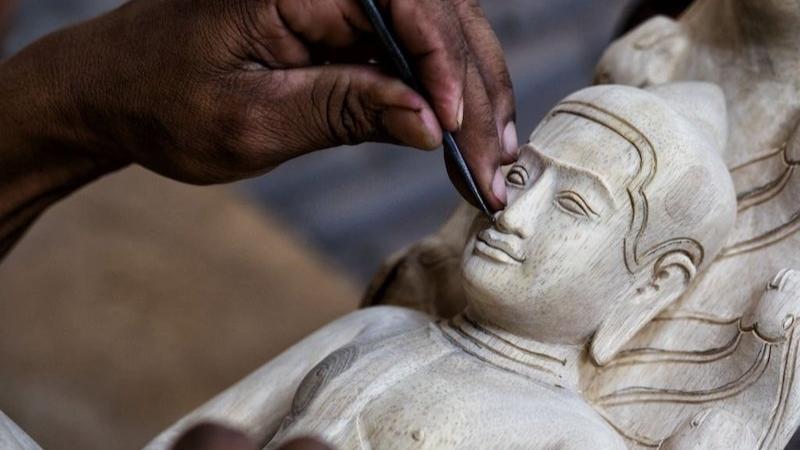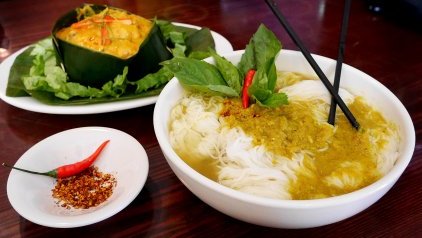Cambodia Arts and Craft - One of the Most Diverse and Abundant Cultures in Southeast Asia
Cambodia is home to some of the most diverse and abundant arts and crafts in Southeast Asia. Throughout Cambodia's history, religious principles guided and inspired its culture. A unique Khmer style emerged from the combination of indigenous animistic beliefs and the originally Indian religions of Hinduism and Buddhism. Music, dance, theater, and cinema flowed strongly through the blood of the Cambodian people.
History of Cambodian Art
Khmer art has roots in the Angkor period. Massive temples from this period, including Angkor Wat and the Bayon at Angkor Thom, testify to the power of Angkor and the grandeur of its architecture and decorative art. The unparalleled achievements in art, architecture, music, dance, and crafts during this period served as models for later cultural development in Cambodia. Today, Cambodia Arts and Crafts is the result of a long history in the past. Among them, the following three periods are the most important.
The Khmer Period
The Khmer Empire lasted from 802 to 1431. During the time, traditional Cambodian art existed in the area around Angkor and mainly at the temple complex of Angkor Wat. After the fall of the empire, these and other sites were abandoned and overgrown, allowing large pieces of architecture and stone carvings to survive to this day.

Cambodia arts in Khmer empire
Pre-colonial Period
In pre-colonial Cambodia, arts and crafts were generally produced by skilled artists producing works for the Royal Palace as well as rural non-specialists. Traditional Cambodian arts and crafts include textiles, non-textile weaving, silversmithing, stone carving, lacquerware, ceramics, wat murals, and kite-making. In modern Cambodia, many artistic traditions entered a period of decline or even ceased to be practiced, but the country has experienced a recent artistic revival as the tourist market has increased and governments and non-government organizations have contributed to the preservation of Cambodian culture.
The 20th Century
In the mid-20th, modern art began in Cambodia. However, by the end of the century, both traditional and modern art declined for several reasons, including the Khmer Rouge. The country then experienced an arts revival recently, with increasing support from governments, NGOs, and foreign tourists.
You may also like: Cambodia Architecture - synonymous with Khmer architecture
Types of Arts & Crafts in Cambodia
Cambodia's arts and crafts are rich and diverse. From the impressive stone carvings of the Angkor period through to exquisite silk weaving, Cambodia or Khmer art is, without a doubt, one of the most richly diverse in the world. Nowadays, Cambodian art can be seen not only in monuments, temples, and museums but also in traditional workshops, which offer a fun and interactive approach to visitors wishing to know more about Cambodian arts and crafts. Among them, the following four types cannot be missed.
Khmer Art
As its name suggests, Khmer Art took its root in the Khmer empire, which settled in the territories of today Cambodia, Thailand, Laos, Vietnam, Burma, and Malaysia. The empire has created a great legacy of immense beauty and artistic footprint for posterity. Khmer art is especially linked to Hindu and Buddhist beliefs. Besides, Javanese and Chinese influences are also recognized. Generally, the kinds of art included architecture, sculpture, carving, and language.
For those who are fond of the Khmer art, it would be a miss if you don't go for this tour - Jewel of Khmer 7 days. Let's check the rate and availablity at BestPrice Travel.
Dancing & Music
Classical dance has been part of Cambodian culture since the royal courts at Angkor. It is a unique contribution to the World’s Culture. Traditionally, dances were done as a sacred ritual, for example, to summon gods and spirits or to offer blessings of prosperity to the king. Carvings of Cambodian classical dancers can be found at many bas reliefs in Angkor Wat or other ancient temples.
Apsara dance, exactly called Khmer Robam Apsara, is the most famous traditional Cambodian arts and crafts. The dance was previously performed only in the Royal Palace of Cambodia. In the 1960s, the Apsara dance was introduced to foreign countries and became more known. The first Apsara dancer was Princess Norodom Bopha Devi, the daughter of King Norodom Sihanouk.

Traditional Apsara dance of Cambodia
In addition to the Apsara dance of the Royal Family, Cambodia also has many other folk dances. They are often fast-paced and performed at festivals. The most popular Cambodian folk dance is the Robam Trot. It acts like a hunter chasing a deer. Robam Trot is performed by people in the New Year with the meaning of warding off bad luck. Another folk dance is Sneak Toseay. This dance depicts the image and graceful movement of animals such as peacocks or tigers.
Today, classic dance is offered at public events, holidays, and as a way to educate tourists about Cambodian culture. There are many tours that welcome tourists to Cambodia through a traditional classical dance performances.
Painting and Sculpture
For many thousands of years, the art of stone carving has flourished in Cambodia. From the small statues made by local artisans to the famous, breathtaking carvings found at Angkor Wat, Angkor Thom, stone carving has become one of the country's most cherished art forms. Stone carving has been both a passion and a livelihood for every Cambodian sculptor. In modern times, however, the art of stone carving has become rare. It is largely because older sculptures have survived undamaged for centuries, eliminating the need for replacement, and due to the use of cement molds for modern temple architecture. By the 1970s and 1980s, the profession of stone carving was almost lost.

Cambodia wooden sculpture
Unlike stone carving, wood painting and sculpture still remain today. These are traditional Cambodian arts and crafts that reflect the strong spiritual beliefs of the locals. Here, visitors can find pillars in the house with intricate carvings of the moon, stars, flowers, and plants. The roof is also engraved with similar details.
Khmer people also worship a wooden statue of "God of the house". In addition, Buddha statues, and carved wooden boxes are used to decorate the interior. Today, many local shops sell intricately carved wooden pieces for visitors to buy as souvenirs.
Textile and Silk
To maintain and meet the growing needs of the tourism industry, the Royal Government of Cambodia has a plan to preserve and develop silk weaving villages to serve tourists.
Silk weaving was introduced to Cambodia in the 13th century and developed along the banks of the Mekong River. This Cambodia art and craft flourished most in the 1960s, but then it declined very quickly due to the influence of the war. After escaping from the Pol Pot in 1979, in 1990, silk weaving in Cambodia was restored and flourished until today.
Currently, silk products are not only used to make scarves, sarongs, or traditional costumes but they are also used to sew into modern costumes, creating a unique and diverse identity for the country. Silk fabric in Cambodia is very soft and can be washed like other fabrics without fading. Patterns are designed with both traditional and modern styles that can be used to sew everyday clothes.

Cambodia handcraft textile
Where to Buy Art & Craft products in Cambodia
Cambodia's arts and crafts now can be easily accessed. As the country is developing tourism, you can find them anywhere, especially in big cities. Some of the recommended places to buy art & craft products included:
- Rehab Craft Cambodia
- Peace Handicraft Shop
- Villageworks – Phnom Penh Handicraft Shop
- Watthan Artisans – Handicraft Shop in Phnom Penh
- Jasmine Boutique
- KNN Cambodia Arts & Crafts
Above are our recommendations for Cambodian arts and crafts. Hopefully, the article can help you with the best experience. If you are planning to travel to Cambodia, don't forget to visit us on our website. We are now providing Cambodia package tours for the best rates and special offers.
Sen The Lotus
(Image Source: Internet)








